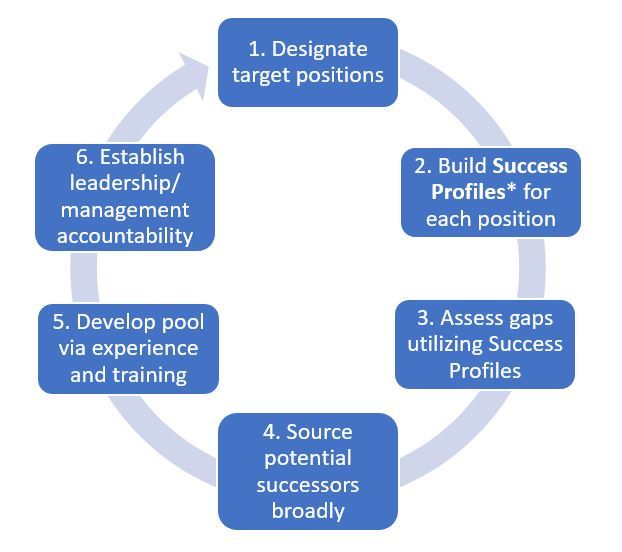What Is Succession Planning and Why Do It?
September 10, 2021 in Keeping Up with Human Capital, Strategic Planning, Workforce Planning
By Tim Brown
Succession planning is essentially workforce planning targeted at a defined set of key positions. It is a future-focused process for developing a pool of talented employees to fill leadership roles in an organization and is a tool for managing human resources strategically. This blog will outline how succession planning can be done using a six-step model, common misconceptions about succession planning, and tips for how to get started. But first, let’s consider some of the potential benefits of succession planning.

Succession planning can:
- Make sufficient numbers of qualified candidates available when key management or technical leadership positions become vacant
- Prepare higher-quality candidates for high-impact positions
- Reduce time required to fill vacancies
- Cut costs by tailoring training and development offerings more closely to long term organizational needs
- Help attract and retain top performers
How Is Succession Planning Done?
The traditional replacement model of succession planning—filling vacancies with individuals who have been groomed or happen to be available—is obsolete and ineffective. Aside from often leading to biased selections, the old model is highly impractical. It is difficult to predict who among a small number of candidates will be available to fill key vacancies years before they occur. The pool model described here instead develops a large number of qualified successors for key managerial and technical positions in the organization.
A six-step model for succession planning

*Success Profiles are a key element of effective succession planning. Like a traditional position description on steroids, they describe the challenges, derailers, critical traits, and job experiences needed to be successful in the position.
In a previous video blog, a similar succession planning model is also discussed by FMPers Marni Falcone and Mike Camburn when they were featured in a webinar by the Society of Industrial Organizational Psychology (SIOP).
What Are Common Misconceptions About Succession Planning?
There are a few common misconceptions about succession planning. In the table below, we debunk theses myths and describe what the reality is for each.
| MISCONCEPTION/MYTH | REALITY |
| Results in unfair pre-selection | Building a pool of qualified successors as recommended here greatly increases the number and diversity of potential successors, making it less likely that selection will be biased or unfair. |
| It’s HR’s job | Succession planning helps senior leadership manage strategically. With their direction and oversight, HR or L&D implement the succession planning program. |
| Ends up as more “shelf ware” | Bring succession planning to life by filling target positions from the pool of candidates that is being developed. |
| It’s too expensive and time consuming | Additional cost is small as most of the tasks involved in succession planning are already being performed. Achieve savings by sharpening the focus of existing training and development programs on future organizational needs. |
How Do We Get Started?
Most organizations have pieces of succession planning in place—training and development programs, career paths, competency models, etc. The goal is to align these pieces to create a coherent succession planning that will produce qualified successors for key positions. Take these steps:
- Identify some target positions
- Build Success Profiles for each position by interviewing supervisors and job incumbents
- Forecast the demand for successors for target positions based on workforce planning data
- Evaluate the current pipeline of potential successors against the Success Profiles and identify the gap that exists
- Align training and development, staff deployment, and career pathing to increase the pool of qualified successors that fit the Success Profiles
It takes years to develop qualified successors for most positions; therefore, organizations should implement succession planning as an iterative process for successive waves of target positions. Apply lessons learned early on to refine the program. If there is just one critical success factor to establishing an effective succession planning program, it is early and active involvement of senior leaders.
Does your organization have a succession planning program in place? Let us know us on LinkedIn!

Preston “Tim” Brown is a Senior Human Capital Consultant on FMP’s team supporting the National Science Foundation. He is a former Federal employee and worked on training and organization development at the US Census Bureau. Tim joined FMP in May following extensive consulting experience at small firms, including The Millennium Group International and Performance Excellence Partners, and larger companies such as PwC and Grant Thornton. Tim first worked on leadership development and succession planning in the private sector and tries to bring those best practices to his federal consulting projects. His favorite past-times include foreign travel—when that is feasible—reading history and fiction classics, backpacking, and wilderness canoeing.